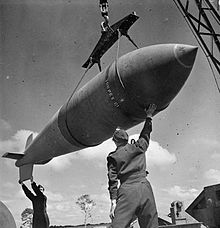
Torpex ("Torpedo explosive") is a secondary explosive, 50% more powerful than TNT by mass.[1] Torpex comprises 42% RDX, 40% TNT and 18% powdered aluminium.[2] It was used in the Second World War from late 1942, at which time some used the names Torpex and RDX interchangeably, much to the confusion of today's historical researchers. Torpex proved to be particularly useful in underwater munitions because the aluminium component made the explosive pulse last longer, which increased the destructive power. Besides torpedoes, naval mines, and depth charges, Torpex was only used in the Upkeep, Tallboy and Grand Slam bombs as well as the drones employed in Operation Aphrodite.[3][4] Torpex has long been superseded by H6 and Polymer-bonded explosive (PBX) compositions.[5][6] It is regarded as obsolete and Torpex is unlikely to be encountered except in old munitions or unexploded ordnance, although a notable exception to this is the Sting Ray lightweight torpedo, which as of October 2020 remains in service with the Royal Navy and several foreign militaries. The German equivalent of Torpex was Trialen.[7]
- ^ Gannon 1996, p. 184.
- ^ Türker, Lemi; Variş, Serhat (2017). "Structurally modified RDX - A DFT study". Defence Technology. 13 (6). Elsevier BV: 385–391. doi:10.1016/j.dt.2017.02.002. hdl:11511/51361. ISSN 2214-9147. S2CID 99529511.
- ^ "Munitions Design". Barnes Wallis Foundation. Retrieved 16 June 2022.
- ^ Webb, Mason B. (18 January 2019). "Operation Aphrodite". Warfare History Network. Retrieved 16 June 2022.
- ^ Graf, M.B.K. (2017). Avro Lancaster. REI. p. 30. ISBN 978-2-37297-333-5.
- ^ Persson, P.A.; Holmberg, R.; Lee, J. (2018). Rock Blasting and Explosives Engineering. CRC Press. p. 73. ISBN 978-1-351-41822-5.
- ^ Fedoroff, B.T.; Kaye, S.M. (1960). Encyclopedia of Explosives and Related Items. Picatinny Arsenal. p. 2-PA55.